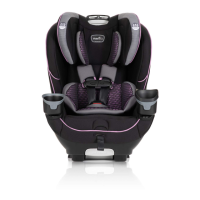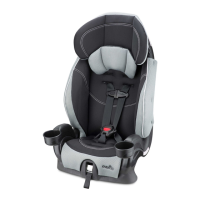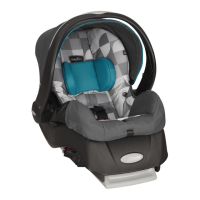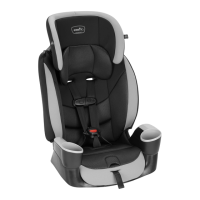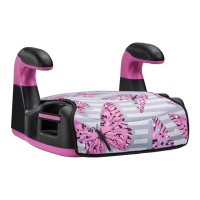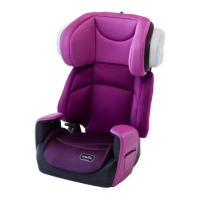Important
Vehicle
Lower
Anchors
Vehicle Top Tether
Anchor Points
Vehicle
Seat
Crease
1514
What is LATCH?
LATCH is an acronym for
(Lower Anchors and Tethers
for CHildren) and refers to a
pair of fixed Lower Anchors
(or bars) and a Top Tether
anchor that are built into
your vehicle, in vehicles built
after September 1, 2002.
The lower LATCH anchors are
located in the crease, or bight,
between the vehicle seat back
and seat cushion, and if not visible,
will typically be indicated
by symbol. Top tether anchors
are located in various places behind the rear vehicle seat.
Center installation in a non-standard LATCH
position:
Center installation of this child restraint is permitted
using inner Lower Anchor Bars from the outside
seating positions if (1) your vehicle manual allows such
installation; and (2) the inner Lower Anchor Bars from
the outside seating positions are 28-51 cm (11-20 in.)
apart.
LATCH typically offers an easier and more consistent
installation. However, this child restraint can be safely
installed using either LATCH or vehicle belts and meets
the requirements of Federal Safety Standard FMVSS 213
with either installation method. Either method is safe for
your child when installed correctly. When using either
method, it is best practice to ALWAYS use tether when
installing in the forward-facing position.
DO NOT install this child restraint with LATCH
and the vehicle’s seat belts at the same time. Your
vehicle owner’s manual may refer to this system as
ISOFIX, Universal Anchorage System (UAS), or Lower
Universal Anchorage System.
The LATCH system is intended to be used ONLY as
described in these instructions. Serious injury or death
may result from misuse. Refer to your vehicle Owner’s
Manual for lower anchor bar positions in your vehicle.
To help prevent serious injury or death:
If you have any of these types of vehicle belt systems
listed, these are SAFE to use to install your child restraint
in the vehicle. Review vehicle owner’s manual for
specific instructions on child restraint installation.
LATCH can be used IN PLACE OF these vehicle belt
types. Refer to the Rear-facing and Forward-facing
weight limits on LATCH use on pages 29 and 40. Refer
to your vehicle owner’s manual for LATCH locations.
Lap Belt with Automatic Locking Retractor (ALR)
The automatic locking retractor
does not allow the lap belt to get
longer once it is buckled. The
vehicle belt is tightened by feeding
seat belt webbing into retractor.
Lap Belt with Locking Latch Plate
Once buckled, the vehicle belt is
tightened by pulling on the free end
of the strap until the belt is tight.
Free end
Lap/Shoulder Belt with Locking Latch Plate
Lap/Shoulder Belt with Sliding Latch Plate
with Locking Retractor
The latch plate slides freely along the
lap/shoulder belt. Vehicle belts with
sliding latch plates are typically locked
at the shoulder belt retractor by
buckling the belt and pulling all of the
webbing out slowly to switch the retractor.
Check vehicle owner’s manual for specific instructions.
The vehicle belt is tightened after switching the retractor
by pulling up on shoulder belt and feeding the webbing
into the retractor.
The lap portion of this belt does not
loosen once the belt is buckled.
The vehicle belt is tightened by
pulling up hard on shoulder belt and
feeding the extra webbing into the
retractor.
WARNING!
DEATH or SERIOUS
INJURY can occur.
LATCH/UAS Warnings
WARNING!
DEATH or SERIOUS
INJURY can occur.
Seat Belt Warnings (cont.)
